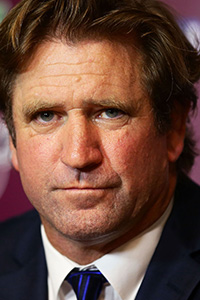
Des Hasler
MAKING use of the latest in data analysis has this season had a transformative effect on the performance of the Manly Sea Eagles, with the Sydney-based NRL team exceeding pre-season expectations by reaching the semi-finals.
Manly was not expected to get into the top eight this year. It finished sixth and then fought its way to the semis.*
By emulating a version of the player analytics techniques that first became widely known in the 2011 film ‘Moneyball’, Manly Sea Eagles head coach Des Hasler is in control of a player dashboard that tells him at a moment’s notice the health and vital signs of his players as individuals and, collectively, the vital signs of the team itself.
‘Moneyball’ was based on the true story of the impoverished Oakland Athletics baseball team in the US that used statistics to find valued low-cost players that traditional player scouts could not see. This led coaches to misjudge their players and mismanage the skills of their teams.
The use of the data transformed team management, especially in the area of assembling a team with a depth of highly competent players that are consistent contributors to the scoreline.
Today, the sports analytics and algorithms are so sophisticated that systems available to a team like Manly, when primed with comprehensive data on both teams coming out on the field, can actually predict the outcome of a game with uncanny accuracy.
The relevance for auto dealers is that similar techniques to those used by Manly this season are available to showroom managers through the systems created for recruiting sales candidates by PerceptionPredict.
PerceptionPredict can use its analysis of the attributes of potential candidates for sales roles to predict the number of cars the candidate is likely to deliver a dealership each month.
Mr Hasler told GoAutoNews Premium that there were strong parallels between sport and business using predictive recruiting analytics for sports team performance and sales performance.
The algorithms at Manly cover off 260 data points which are monitored to the minute – and by the metre – and flow through to the coaching staff for recruiting, for team selection and throughout the game.
“We are rating them to the minute,” Mr Hasler said, “and if a player is not having a good day we start asking, ‘Is that a trend? Is that something that is starting to happen a lot, and how can we make that better?’ So, based on the analytics, we are constantly trying to bring those numbers and their contribution rates up to be more and more positive.
“That is where the analytics is proving to be really important because what you do is motivate and get inside that competitive capacity which is a major variant or attribute that sports- and businesspeople have.
“The coaches are constantly reviewing on those 260 data points across the board. But what we then do is look at the high-impact contributions like try calls, try assist, line break assist, line break calls, tackles missed, chases, all that kind of thing.”
Mr Hasler said the coaches look at all those high-impact contributions and players can see where they are rated and from there they see what they need to do to improve and that improvement combines across each player into the team as a whole.
“What we do is break it down into defence and offence; which is attacking,” he said. “Then we break that down into each metre – an offence metre and a defensive metre. So the player is rated in each one metre they step on the football field. We will rate them on what they do in that one metre offensively and one metre defensively.
“So they know what they have to do and they know that in that one metre, say an attack metre, they know what they have to improve: slow play of the ball, quick play of the ball, missed tackle, half missed tackle, contribution tackle.
“That is their bread and butter and that is how we see analytics helping players to improve their lifelong learnings in the game.
“And it is not just to improve, it is to adulate as well. Because if someone is doing something really well then that is fantastic.
“Then, of course, those players who are performing at the higher end of those performance models, and making a high-impact contribution, they are the one who obviously are paid more money. And you can see those player trends evolving all the time.”
Asked how he thought analytics has helped Manly, Mr Hasler said: “It helps the player to understand what lifelong learning is about. They are already competitive. By the time they get to NRL level they have an incredible competitive capacity. That is a given.
“The one you really work on is that lifelong learning; how do I keep that competitive capacity at its premium, at its optimum? How do I improve it? How do I maintain it? How do I not go off the rails? How do I keep it all related? Then you have to see how it works in terms of each high-performance unit module. It is very complex,” he said.
* NRL Footnote: Manly lost its semi-final which followed a controversial call to sin-bin one of its best players Jake Trbojevic with the game in the balance but with Manly in the lead. At the time, the Manly coach was looking at data that showed his team “could have won three times over” but the data did not predict that a referee would apparently harshly take it upon himself to have Manly play out the match with one key player sitting it out.
By John Mellor














 Read More: Related articles
Read More: Related articles

